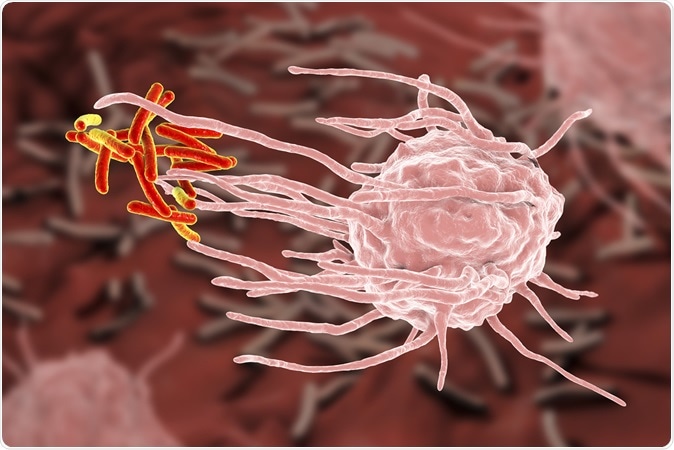Researchers from Sydney have found that the body contains a special structure that can act as front line soldiers in case of infections. These are the cells that could be the main agents in preserving vaccine-memory, they find.
The latest study titled, “Memory B cells are reactivated in subcapsular proliferative foci of lymph nodes,” appears this week in the journal Nature Communications.

Macrophage engulfing tuberculosis bacteria Mycobacterium tuberculosis, 3D illustration. Image Credit: Kateryna Kon / Shutterstock
According to researchers, this study reveals why some diseases can provide life-long immunity while others do not. Dr Imogen Moran, PhD student along with her supervisor at the Garvan Institute in Darlinghurst, Associate Professor Tri Phan, have called this small structure that preserves vaccine memory – “subcapsular proliferative foci” or SPF for short. It is a small structure as big as the tip of the little finger and is present within the lymph nodes on the neck and in the under arms. These nodes enlarge when a person gets infected, otherwise they remain invisible. The SPF, according to the researchers, waits for an infection to strike. When it encounters an infection, it mounts an immune response against it explain the researchers.
In persons with an SPF, the reaction is two days faster than among people who do not have SPF says Professor Phan. He explained that the immune system needs to immediately take charge and control the infection to prevent it from overwhelming the body. He said that since the bacteria are capable of dividing and spreading quickly, “time is of essence” to stop them in their tracks.
According to the researchers, the SPF is nothing but a dense cluster of immune cells. These cells contain scout cells that can look around searching for infections such as bacteria and viruses. It also contains factory cells that are needed to make the antibodies. The two types of cells contained in the SPF are antigen-presenting subcapsular sinus macrophages and T follicular helper cells. The SPF stays small and insignificant when a person is well, they explain. As soon as the scout cells encounter a virus or a bacterial cell, it signals the SPF that increases in size and starts making antibodies to kill the infection. The infection thus can be killed before it can take hold, explained Professor Phan.
Professor Phan added that when vaccines are administered, certain memory cells or memory B cells are trained to recognize the microbes. He said that these trained cells can all migrate to the SPF after vaccine administration where they remain until the virus or bacteria actually strikes. The SPF, he said, is the “seat of immune memory”. This also explains why immunity cannot be developed against certain infections such as HIV, malaria, dengue etc.
What is surprising is that SPF as a structure has been missed by scientists till now. This team of researchers sliced up the lymph node and found it to run vertically through the lymph gland. Up until now the lymph nodes were seen only in microscopically thin slices and thus this structure probably evaded them, speculated Phan. Human lymph nodes as well as mouse lymph nodes contain SPF. Researchers suggest that this structure could be same across evolution. The team concludes, “These data establish the SPF as the seat of B cell memory, and as an evolutionarily conserved immune response pathway that may be targeted to improve human vaccine efficacy.”